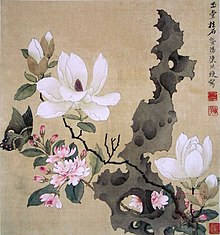Intensity
What enables painting is the perception and representation of intensity. Every point in space has different intensity, which can be represented in painting by black and white and all the gray shades between. In practice, painters can articulate shapes by juxtaposing surfaces of different intensity; by using just color (of the same intensity) one can only represent symbolic shapes. Thus, the basic means of painting are distinct from ideological means, such as geometrical figures, various points of view and organization (perspective), and symbols. For example, a painter perceives that a particular white wall has different intensity at each point, due to shades and reflections from nearby objects, but ideally, a white wall is still a white wall in pitch darkness. In technical drawing, thickness of line is also ideal, demarcating ideal outlines of an object within a perceptual frame different from the one used by painters. |
| Chen Hongshou (1598–1652), Leaf album painting (Ming Dynasty) |
Color and tone
Color and tone are the essence of painting as pitch and rhythm are of music. Color is highly subjective, but has observable psychological effects, although these can differ from one culture to the next. Black is associated with mourning in the West, but in the East, white is. Some painters, theoreticians, writers and scientists, including Goethe, Kandinsky, and Newton, have written their own color theory. Moreover the use of language is only a generalization for a color equivalent. The word "red", for example, can cover a wide range of variations on the pure red of the visible spectrum of light. There is not a formalized register of different colors in the way that there is agreement on different notes in music, such as C or C♯ in music. For a painter, color is not simply divided into basic and derived (complementary or mixed) colors (like red, blue, green, brown, etc.).Painters deal practically with pigments, so "blue" for a painter can be any of the blues: phtalocyan, Paris blue, indigo, cobalt, ultramarine, and so on. Psychological, symbolical meanings of color are not strictly speaking means of painting. Colors only add to the potential, derived context of meanings, and because of this the perception of a painting is highly subjective. The analogy with music is quite clear—sound in music (like "C") is analogous to light in painting, "shades" to dynamics, and coloration is to painting as specific timbre of musical instruments to music—though these do not necessarily form a melody, but can add different contexts to it.

0 komentar:
Posting Komentar